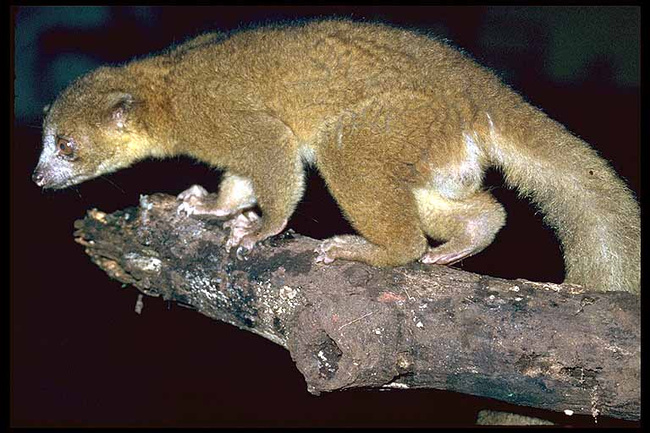
More about Olingo
Habitat
Olingos live in tropical evergreen forests below 2,000 m in elevation.
Range
The Olingo lives from southern Nicaragua to Ecuador and east of the Andes from Venezuela and Guyana to Bolivia in the western half of the Amazon basin.
Physical Description
This solitary mammal has drab brown, long, soft, dense fur, with darker fur on top of its head. Its underside is paler. The olingo is equipped with large, round brown eyes with a bright eyeshine, small ears, and an extremely long tail that is longer than its head and body. The tail helps distinguish this night creature from the kinkajou because the olingo's tail is banded and nonprehensile; the olingo also carries its tail straight out behind it when traveling, whereas the kinkajou keeps its tail curled around branches as it moves. A kinkajous also are twice the weight of an olingo, their fur is shorter and more reddish, and of course, they have a prehensile tail.
Biology and Natural History
There are six olingo species in Central and South America, all with minor differences from the others. The olingo is a nocturnal, arboreal omnivore related to the raccoon.
Agile and active, the olingo stays high in the canopy, lightly passing through the branches, feeding quickly, and moving on. It is a noisy traveler but not so much as the kinkajou. Olingos use an alarm call if necessary, and less often a sneezing vocalization. They may feed in the same trees as kinkajous and night monkeys, but adults usually forage alone, and they are less social than kinkajous. During the day, olingos shelter in hollow trees. A female will have a single baby after a 73-74 day gestation period, and the infant is small and gray-brown with faint dark stripes.
The olingo is not as adaptive as the kinkajou to disturbed forest or human-use areas. Perhaps it is for this reason that the olingo is not as common as the kinkajou, although they are still widespread. The olingo is less hunted than the kinkajou, but they are still very threatened by deforestation.
Diet
Similar to kinkajous, olingos eat fruit (especially figs), invertebrates, and small vertebrates; in the dry season they also drink nectar from some flowers such as balsa. The olingo is more carnivorous than the kinkajou.
Height/Weight
The olingo head and body length is generally 0.36 to 0.41 m, with a tail as long or longer, of 0.37 to 0.52 m. Adults weigh 1.1-1.4 kg.
Brief Taxonomy
Order: Carnivora
Family: Procyonidae
Sources
Eisenberg, John. Mammals of the Neotropics, Vol. 1. The University of Chicago Press: Chicago, 1989.
Emmons, Louise H. Neotropical Rainforest Mammals: A Field Guide, 2nd Ed. University of Chicago Press: Chicago, 1990.
Wilson, D. E. in Janzen, Daniel H. Costa Rican Natural History. Chicago: University of Chicago Press, 1983.
-Amy Strieter, Wildlife Writer
Olingo Sightings
Similar Profiles
It's more than just having a good time or visiting beautiful places (although that's absolutely a part of it!), it's about being part of a unique experience that stays with you.



